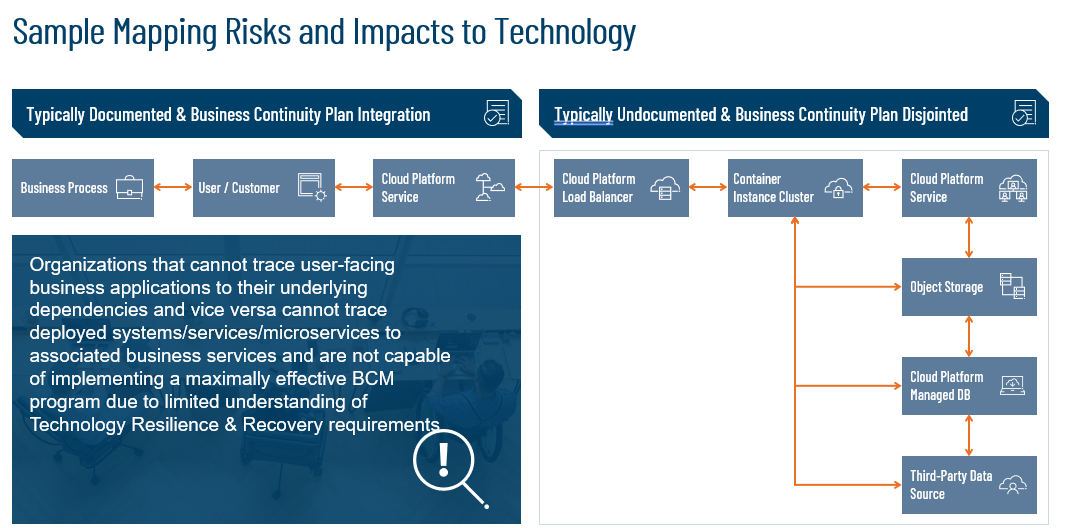Cloud infrastructure has emerged as a critical factor for driving business success. Ensuring cloud resilience isn’t just desirable, it’s essential as application downtime means lost revenue. A comprehensive approach to cloud resilience ensures that when failures occur, systems can recover quickly, continue to deliver value and maintain business continuity in the face of disruptions. This approach, known as operational resilience, has become a top priority for organizations globally.
Resiliency patterns safeguard cloud systems from unexpected disruptions. These strategies protect technical infrastructure and drive business reliability and growth.
Resiliency architecture: Designing for scalability and flexibility
Workload resiliency architecture is essential for creating cloud systems that can adapt dynamically to changes in demand, whether planned or unexpected. In a resilient architecture, systems are designed to scale up or down automatically to handle peak loads, avoid performance degradation and gracefully handle disruptions.
Workload resilience:
- Proactive system design with Failure Mode and Effects Analysis (FMEA): Utilize techniques like FMEA to proactively identify critical components that are susceptible to failure. This ensures that these services are equipped to scale automatically and helps in understanding the ripple effect of these components across the application and any dependent applications.
- Adaptive resource management: Design services to dynamically allocate and reallocate resources to cater to fluctuating workloads, especially for components that handle critical transactions or large volumes of data. This adaptability ensures the system can handle varying demands without compromising performance.
- Auto-scale across availability zone: Implement auto-scaling capabilities across availability zones (or regions) that activate when certain thresholds are met. This provides a safety net that ensures critical services maintain performance under peak loads.
Monitoring: The foundation of cloud resilience
Continuous monitoring is the cornerstone of resilience. It provides real-time insights into system performance, resource utilization and potential failures, allowing teams to proactively address issues before they impact the business.
Key elements of effective monitoring:
- Real-time alerts: Automatically notify teams when metrics like latency, error rates or resource usage cross critical thresholds, enabling rapid response.
- End-to-end visibility: Use tools that provide comprehensive insights into all cloud resources and services, from computing and storage to networks and applications.
- Predictive analysis: Leverage data from monitoring tools to anticipate and prevent failures by identifying trends and potential bottlenecks.
Disaster recovery testing: Ensuring business continuity
A disaster recovery plan is crucial, but regularly testing it is equally important. Disaster recovery (DR) testing ensures that failover systems and recovery processes work when needed most.
Key aspects of DR testing:
- Simulate outages: Test recovery strategies by simulating data center outages, network disruptions or service failures. This validates the organization’s ability to recover in real-time scenarios.
- Automated failover: Automate failover processes to ensure fast, reliable recovery with minimal human intervention.
- Validate backups: Confirm that backups are accurate and complete to confidently restore services without data loss.
Exception handling: Reducing the impact of failures
Failures in cloud systems are inevitable, but well-designed exception handling can minimize their impact. By catching and managing errors gracefully, exception handling ensures services can continue functioning even when things go wrong.
Best practices for exception handling:
- Localized error resolution: Catch and resolve errors at the service or component level to prevent them from spreading across the system.
- Fallback strategies: Implement fallback mechanisms to provide degraded service, such as a read-only mode, when core functionality is unavailable.
- Logging for analysis: Log all exceptions with detailed information for future diagnosis and resolution, allowing teams to improve continuously.
Idempotency: Ensuring consistency in the face of failures
In distributed cloud environments, ensuring that operations can be safely retried without unintended side effects is critical. The concept of idempotency guarantees that a request can be processed multiple times with the same result, providing consistency across all interactions.
Why idempotency is essential:
- Eliminates duplicates: Prevents unintended duplication of processes or transactions, ensuring data consistency.
- Enables safe retries: The system can safely retry failed operations without causing data integrity issues.
- Improves reliability: Particularly useful in payment processing or API requests, where ensuring the same outcome despite failures is critical.

Chaos engineering: Proactively testing for resilience
Chaos engineering is the practice of intentionally introducing failures into a system to observe how well it can handle disruptions. This proactive approach helps identify weaknesses before they impact production environments, enabling teams to strengthen their systems.
How chaos engineering works:
- Inject failures: To test how systems respond and simulate real-world disruptions, such as shutting down servers, introducing network outages, or introducing high latency.
- Monitor outcomes: Track how well your system recovers and whether unforeseen weaknesses in the architecture need attention.
- Continuous improvement: Use findings from chaos tests to implement fixes, enhancing overall system resilience.
Circuit breaker techniques: Preventing cascading failures
The circuit breaker pattern is designed to protect systems from being overwhelmed by isolating failures before they cascade through the infrastructure. When a service or component consistently fails, the circuit breaker trips, preventing further damage and giving the system time to recover.
How the circuit breaker works:
- Monitor failure rates: Track how often a service fails. If the failure rate exceeds a certain threshold, the circuit breaker temporarily halts service requests.
- Recovery period: After the circuit breaker trips, it allows a cool-off period, during which the service can recover.
- Gradual re-entry: Once the system shows signs of recovery, a small number of requests are allowed to pass through to test stability before fully restoring the service.
Cost management: Strategic implementation of resiliency patterns
While these patterns are invaluable for maintaining system reliability, they can introduce additional operational and infrastructure costs. To balance resilience with cost-efficiency:
- Prioritize high-impact areas or critical systems: Focus on applying resiliency patterns to mission-critical systems and services where failure would have the most significant financial or reputational impact. This reduces the complexity and cost of deploying these patterns system-wide.
- Leverage cloud provider tools: Major cloud providers like AWS, Azure and Google Cloud offer a wide range of built-in tools to support resiliency patterns (e.g., monitoring, DR, circuit breaking) at competitive pricing. Use these tools to reduce the cost of custom-built solutions.
- Optimize resource usage: Use monitoring and cost-optimization tools to ensure that resources are not over-provisioned. Auto-scaling and resource right-sizing can significantly reduce cloud infrastructure costs while maintaining resiliency.
- Automate where possible: Automation reduces human intervention and operational overhead. Automate DR testing, failover processes and exception handling to reduce labor costs and improve efficiency.
- Consider open-source solutions: Where appropriate, use open-source tools for monitoring, logging and chaos engineering. These tools often provide robust functionality at a lower cost than commercial alternatives.
Building a holistic cloud resilience strategy
A comprehensive approach to cloud resilience ensures that when failures occur, systems can recover quickly, continue to deliver value and maintain business continuity in the face of disruptions. Investing in cloud resiliency patterns is an investment in the long-term success of any business. By fostering a resilient cloud infrastructure, the organization is empowered to continuously deliver value, adapt to change and outperform competitors in an increasingly digital world.
For more information about our technology resilience solutions, contact us or download our Guide to Business Continuity and Resilience or refer other thought leadership we’ve published on this topic, including Achieving Resilience Starts at the Top, Data Recovery Principles for Financial Institutions and The Strategic Imperative of Enterprise Resilience.






